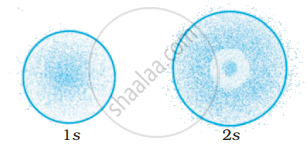Advertisements
Advertisements
Question
Explain the anomalous behaviour of copper.
Solution
- Copper (Cu) has atomic number 29.
- Its expected electronic configuration is 1s2 2s2 2p6 3s2 3p6 4s2 3d9.
- The 3d orbital is neither half-filled nor fully filled. Hence, it has less stability.
- Due to interelectronic repulsion forces, one 4s electron enters into a 3d orbital. This makes 3d orbital completely filled and 4s orbital half-filled which gives extra stability and the electronic configuration of Cu becomes, 1s2 2s2 2p6 3s2 3p6 4s1 3d10.
APPEARS IN
RELATED QUESTIONS
Using s, p, d notations, describe the orbital with the following quantum numbers n = 4; l =3.
Choose the correct option.
Principal Quantum number describes -
State Heisenberg uncertainty principle.
State and explain Pauli’s exclusion principle.
State Hund’s rule of maximum multiplicity with a suitable example.
Write electronic configurations of \[\ce{Fe, Fe2+, Fe3+}\].
Write condensed orbital notation of electronic configuration of the following element:
Carbon (Z = 6)
Write condensed orbital notation of electronic configuration of the following element:
Silicon (Z = 14)
Draw shapes of 2s orbitals.
If n = 3, what are the quantum number l and m?
The principal quantum number (n) and magnetic quantum number (ml) for the valence electrons of rubidium atom (Z = 37) are ____________ respectively.
The designation of a subshell with n = 6 and l = 2 is ____________.
Which of the following has a greater number of electrons than neutrons?
(Mass number of Mg, C, O and Na is 24, 12, 16 and 23 respectively).
Which of the following options does not represent ground state electronic configuration of an atom?
The probability density plots of 1s and 2s orbitals are given in Figure:

The density of dots in a region represents the probability density of finding electrons in the region.
On the basis of above diagram which of the following statements is incorrect?
The number of radial nodes for 3p orbital is ______.
Number of angular nodes for 4d orbital is ______.
Which of the following sets of quantum numbers are correct?
| `n` | `l` | `m_l` | |
| (i) | 1 | 1 | +2 |
| (ii) | 2 | 1 | +1 |
| (iii) | 3 | 2 | –2 |
| (iv) | 3 | 4 | –2 |
Nickel atom can lose two electrons to form \[\ce{Ni^{2+}}\] ion. The atomic number of nickel is 28. From which orbital will nickel lose two electrons.
Match the following
| (i) Photon | (a) Value is 4 for N shell |
| (ii) Electron | (b) Probability density |
| (iii) ψ2 | (c) Always positive value |
| (iv) Principal quantum number n | (d) Exhibits both momentum and wavelength |
Match species given in Column I with the electronic configuration given in Column II.
| Column I | Column II |
| (i) \[\ce{Cr}\] | (a) [Ar]3d84s0 |
| (ii) \[\ce{Fe^{2+}}\] | (b) [Ar]3d104s1 |
| (iii) \[\ce{Ni^{2+}}\] | (c) [Ar]3d64s0 |
| (iv) \[\ce{Cu}\] | (d) [Ar] 3d54s1 |
| (e) [Ar]3d64s2 |
Choose the INCORRECT statement
Which of the following is the correct plot for the probability density ψ2 (r) as a function of distance 'r' of the electron from the nucleus for 2s orbitals?
In assigning R - S configuration, which among the following groups has highest priority?
In the case of R, S configuration the group having the highest priority is ______.
